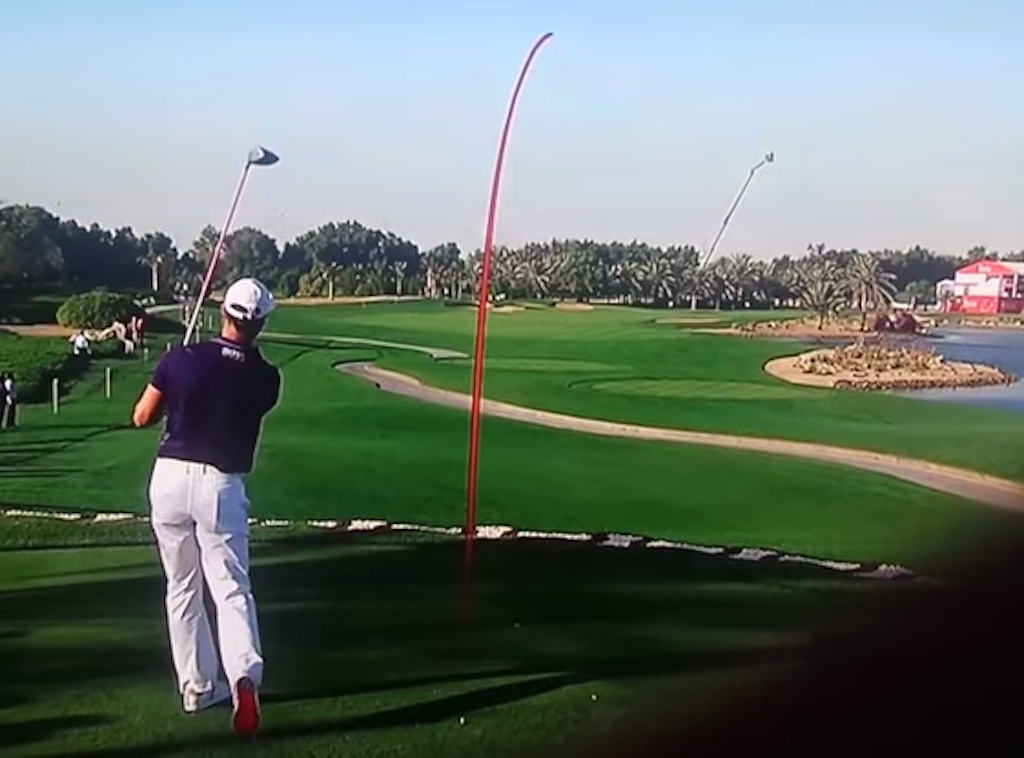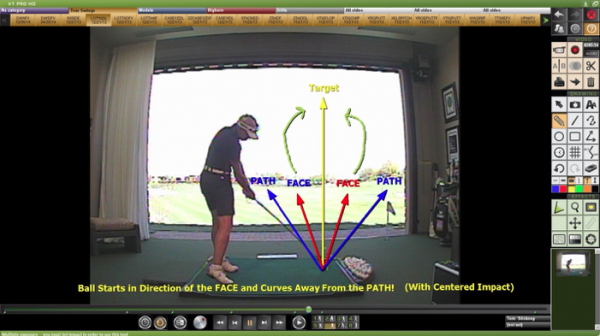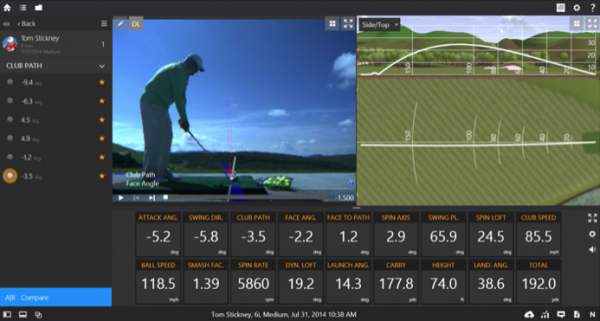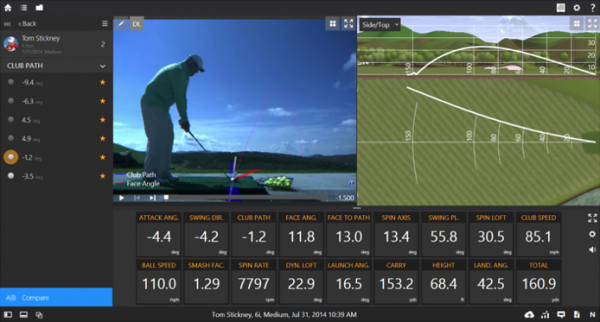Instruction
Turn your weak fade into a power fade

When I see most golfers hit a “cut” or a “fade,” it’s usually a weak shot that curves away from their intended target. That’s because most golfers use a “wiping” motion to hit the shot, and that creates a ball flight with little power that tends to spray offline.
What I’d like to do with this article is help golfers learn how to hit a “power fade,” which won’t suffer a loss in yardage and will increase control.
A power fade is more accurately labeled as a “release fade,” because it allows golfers to fully release the club through impact. I’ll explain it below in terms of a right-handed golfer, so if you’re left-handed, simply reverse the directions.
To hit a power fade, have the club face pointed left of the target at impact, and have a club path that is pointed left of the club face. So even though the club face is pointed left of the target at impact, it’s still “open” in relation to the club path, which is why the ball curves from left to right.
The wipe fade has more of a “holding on” action through impact that feels like a block. The club face is open to the target and the path, so the ball will start right of the target and go farther to the right, creating the weak, slicing ball flight that most golfers have.
Remember, golfers are always trying to position the club face at impact between the swing path and their intended target. It allows the ball to begin in the correct direction before curving back to the target. Whenever the club face does not fit between the target and the club path, the starting direction will be incorrect and the curvature will work against the shot golfers are trying to hit.
The blue line above — the one the left — indicates swing path. It is far enough left of the target (yellow line) to allow the club face (red line) room to fit between the path and the intended target.
Let’s use Trackman to show you how these shots are created.
The Release Fade
- The face is between the path and the target.
- The swing path is left of the intended target by -3.5 degrees.
- The face angle is LEFT of the target by -2.2 degrees and RIGHT of the path by 1.2 degrees.
- Whenever the club face is right of the path, the ball will move left to right. This, of course, assumes that the golfer hits the ball on the center of the club face.
The Wipe Fade
- The face is NOT between the path and the target, so the starting direction is incorrect.
- The swing path is left of the intended target by -1.2 degrees.
- The face angle is RIGHT of the target by 11.8 degrees and RIGHT of the path by 13 degree
- Whenever the face is right of the path, the ball will move left to right; however when the face is also RIGHT of the target, the ball will now begin too far right of the target and then curve away from the target even farther. Both of these scenarios assume centered contact.
The trouble here is that the swing path is almost zeroed out, or too close to the intended target for the player to actually “release” the club without the danger of the ball double-crossing leftward. Therefore, the player “holds on” through impact and keeps the face pointed wide right of the target, not just the path. A push-slice ensues.
So the question remains, “How does one learn how to hit the ‘release fade?’”
First, you must find a swing path that is far enough leftward so that you can feel like you can fully release the club without hitting a “double-cross.” You will have to experiment with different face angles and club paths, as the amount differs for most players.
Second, experiment with different release feels that still allow the ball to curve from left to right with the ball beginning LEFT of the target. Your release feels should be defined as your natural release, not a “hold-on” release.
Third, shifting the path far enough left of your natural release feeling will allow the ball to begin left of the target, yet still curve back toward the target
If you double cross yourself, your path isn’t leftward enough to accommodate your “release.” Aim more left.
Experiment and have fun!
- LIKE123
- LEGIT16
- WOW7
- LOL6
- IDHT3
- FLOP5
- OB7
- SHANK23
Instruction
Clement: Laid-off or perfect fade? Across-the-line or perfect draw?

Some call the image on the left laid off, but if you are hitting a fade, this could be a perfect backswing for it! Same for across the line for a draw! Stop racking your brain with perceived mistakes and simply match backswing to shot shape!
- LIKE0
- LEGIT0
- WOW0
- LOL0
- IDHT0
- FLOP0
- OB0
- SHANK1
Instruction
The Wedge Guy: The easiest-to-learn golf basic

My golf learning began with this simple fact – if you don’t have a fundamentally sound hold on the golf club, it is practically impossible for your body to execute a fundamentally sound golf swing. I’m still a big believer that the golf swing is much easier to execute if you begin with the proper hold on the club.
As you might imagine, I come into contact with hundreds of golfers of all skill levels. And it is very rare to see a good player with a bad hold on the golf club. There are some exceptions, for sure, but they are very few and very far between, and they typically have beat so many balls with their poor grip that they’ve found a way to work around it.
The reality of biophysics is that the body moves only in certain ways – and the particulars of the way you hold the golf club can totally prevent a sound swing motion that allows the club to release properly through the impact zone. The wonderful thing is that anyone can learn how to put a fundamentally sound hold on the golf club, and you can practice it anywhere your hands are not otherwise engaged, like watching TV or just sitting and relaxing.
Whether you prefer an overlap, interlock or full-finger (not baseball!) grip on the club, the same fundamentals apply. Here are the major grip faults I see most often, in the order of the frequency:
Mis-aligned hands
By this I mean that the palms of the two hands are not parallel to each other. Too many golfers have a weak left hand and strong right, or vice versa. The easiest way to learn how to hold the club with your palms aligned properly is to grip a plain wooden ruler or yardstick. It forces the hands to align properly and shows you how that feels. If you grip and re-grip a yardstick several times, then grip a club, you’ll see that the learning curve is almost immediate.
The position of the grip in the upper/left hand
I also observe many golfers who have the butt of the grip too far into the heel pad of the upper hand (the left hand for right-handed players). It’s amazing how much easier it is to release the club through the ball if even 1/4-1/2″ of the butt is beyond the left heel pad. Try this yourself to see what I mean. Swing the club freely with just your left hand and notice the difference in its release from when you hold it at the end of the grip, versus gripping down even a half inch.
To help you really understand how this works, go to the range and hit shots with your five-iron gripped down a full inch to make the club the same length as your seven-iron. You will probably see an amazing shot shape difference, and likely not see as much distance loss as you would expect.
Too much lower (right) hand on the club
It seems like almost all golfers of 8-10 handicap or higher have the club too far into the palm of the lower hand, because that feels “good” if you are trying to control the path of the clubhead to the ball. But the golf swing is not an effort to hit at the ball – it is a swing of the club. The proper hold on the club has the grip underneath the pad at the base of the fingers. This will likely feel “weak” to you — like you cannot control the club like that. EXACTLY. You should not be trying to control the club with your lower/master hand.
Gripping too tightly
Nearly all golfers hold the club too tightly, which tenses up the forearms and prevents a proper release of the club through impact. In order for the club to move back and through properly, you must feel that the club is controlled by the last three fingers of the upper hand, and the middle two fingers of the lower hand. If you engage your thumbs and forefingers in “holding” the club, the result will almost always be a grip that is too tight. Try this for yourself. Hold the club in your upper hand only, and squeeze firmly with just the last three fingers, with the forefinger and thumb off the club entirely. You have good control, but your forearms are not tense. Then begin to squeeze down with your thumb and forefinger and observe the tensing of the entire forearm. This is the way we are made, so the key to preventing tenseness in the arms is to hold the club very lightly with the “pinchers” — the thumbs and forefingers.
So, those are what I believe are the four fundamentals of a good grip. Anyone can learn them in their home or office very quickly. There is no easier way to improve your ball striking consistency and add distance than giving more attention to the way you hold the golf club.
More from the Wedge Guy
- The Wedge Guy: Golf mastery begins with your wedge game
- The Wedge Guy: Why golf is 20 times harder than brain surgery
- The Wedge Guy: Musings on the golf ball rollback
- LIKE86
- LEGIT13
- WOW6
- LOL1
- IDHT0
- FLOP4
- OB1
- SHANK8
Instruction
Clement: Stop ripping off your swing with this drill!

Not the dreaded headcover under the armpit drill! As if your body is defective and can’t function by itself! Have you seen how incredible the human machine is with all the incredible feats of agility all kinds of athletes are accomplishing? You think your body is so defective (the good Lord is laughing his head off at you) that it needs a headcover tucked under the armpit so you can swing like T-Rex?
- LIKE0
- LEGIT2
- WOW2
- LOL0
- IDHT0
- FLOP0
- OB0
- SHANK2
-

 19th Hole2 weeks ago
19th Hole2 weeks agoDave Portnoy places monstrous outright bet for the 2024 Masters
-

 19th Hole3 days ago
19th Hole3 days agoJustin Thomas on the equipment choice of Scottie Scheffler that he thinks is ‘weird’
-

 19th Hole2 weeks ago
19th Hole2 weeks agoTiger Woods arrives at 2024 Masters equipped with a putter that may surprise you
-

 19th Hole3 days ago
19th Hole3 days ago‘Absolutely crazy’ – Major champ lays into Patrick Cantlay over his decision on final hole of RBC Heritage
-

 19th Hole2 weeks ago
19th Hole2 weeks agoTwo star names reportedly blanked Jon Rahm all week at the Masters
-

 19th Hole1 week ago
19th Hole1 week agoReport: LIV Golf identifies latest star name they hope to sign to breakaway tour
-

 19th Hole1 week ago
19th Hole1 week agoNeal Shipley presser ends in awkward fashion after reporter claims Tiger handed him note on 8th fairway
-

 19th Hole1 week ago
19th Hole1 week agoBrandel Chamblee has ‘no doubt’ who started the McIlroy/LIV rumor and why



















dave
Oct 23, 2016 at 9:35 am
Hi Tom
do you do online lessons. Regards
Dave
Josh
Apr 15, 2015 at 2:39 pm
Very solid write up. I’m not quite sure why so many people are bashing this article. Simply because the method he describes is not the same as is taught by others, or the same method you personally find best suits your swing, does not mean that his analysis was incorrect. To me, the big key here is being able to fully release the club head and still produce a left-to-right shot. Being a natural drawer of the golf ball, learning to hit a fade was–and still is–a difficult process for me. I tend to hit weak, “hold-off” fades every time rather than fulling releasing the club head and hitting controlled, “power” fades. Although I’m still not a fan of a left-to-right ball flight (it just looks ugly to me), being able to hit a power fade when the shot calls for one is an essential tool for anyone who wants to compete at a higher level. This article merely simplifies the process a bit.
Maximilian Weber
Apr 11, 2015 at 1:05 pm
wrong on so many levels…. a power fade is played with an inside swing path not coming over the top. lol. “great” article. no wonder you are not getting any distance on that ball if you’re coming from the outside WITH an open clubface
BKR
Apr 9, 2015 at 2:16 am
I think your data shows a power fade and a “wiping” slice, but not for the reason you point out. You are saying that “wiping” is causing a loss of distance. But you are saying that the “wiping” is due simply to the same swing and path/face relationship being pointed in a different direction (on the “wrong side” of the target/aim line), when, in fact, the reason “wipe fade” goes so much shorter is because of the huge face to path angle difference, not the direction of the path. The distance loss has nothing to do with the fact that the path is left of target/aim line or right of target/aim line, it has to do with the fact that the face angle on the “release fade” in the article is very close to the path angle, thus creating much less curve and much more distance. This is proven by Fred Couples who hits a push fade where his aiming point or “target line” are way left of his actual target and he simply swings in-to-out but has the face slightly open to that path, creating a small power fade, and he certainly does not lose any distance. So, if you have a swing like the “release fade” in the article (face-to-path of 1.2) and turned the path any amount to the right (as would be humanly possible), it would be the same shot, it would just be further right and you would have to aim further left, a la Freddy. So, given this, are you actually saying that you get more distance if you hit a pull fade vs. a push fade (assuming the same face-to-path ratio), because I have read articles and heard teachers say that the push cut (that Couples plays) is actually better for distance? If so, I would be very interested to see your trackman data showing a 1.2 face-to-path for a path of -3.5 going farther than 1.2 face-to-path for a path of 0.5, taking into account that it would be farther right and therefore “shorter” for that specific target line.
JP
Apr 8, 2015 at 2:15 pm
Thanks Tom. I’ve been working on this stuff for both a fade and a draw and this lines up exactly with what I do when I’m successful at hitting either shot. It’s nice to have it laid out in such an easy to understand way!
Mike T
Apr 8, 2015 at 1:56 pm
I play to a power fade, but am prone to a double cross and when things go really wrong, a big slice. The problem remains: “How does one learn how to hit the ‘release fade?’”. Consistency is a big issue for us higher handicap, so although I understand the data from the flight monitor, it really does me little good in relation to my driver swing. I need more how’s and less techno babble.
Aaron suarez
Apr 8, 2015 at 12:20 pm
Nice article Tom, I love when you do these kinda articles. It would be cool to see an article on the difference in distance between a fade and draw with a short iron a medium and long iron as I think most people wold be suprised by the difference and the change as the loft decreases. Also would be interesting to do s test where you hit straight balls and 10 20 30 and 40 yard cuts or draws and show the different carry distances. Fun stuff.
Jafar
Apr 8, 2015 at 11:49 am
How should your shoulders and hips be aligned?
SJ
Apr 8, 2015 at 7:47 am
Back when I did club fittings customers would always say their typical ball flight is a “power fade.” So I always thought a “power fade” was just an uncontrollable slice.
Tom Stickney
Apr 8, 2015 at 12:59 am
Double…you can’t be serious
Neige
Apr 7, 2015 at 9:08 pm
Informative. Thanks!
Double Mocha Man
Apr 7, 2015 at 6:58 pm
Is this article an April Fool’s Joke cuz it’s ridiculous
Full of lies but what else should we expect from Tom.
Right guys?
TheCityGame
Apr 8, 2015 at 9:39 am
No.
You should try to articulate what it is you think is ridiculous.
tom stickney
Apr 7, 2015 at 3:58 pm
Kevin– I would say that is correct, sir
Kevin
Apr 7, 2015 at 2:49 pm
So let’s take your article here with a twist. First off I’m left handed. My typical ball flight is a draw. However, after the winter months (clubs 5 months in the corner) the ball flight is right to left. I have the technology to know my path is to the left, but not sophisticated enough to tell me face angle. Could I interpret this information in the article to help bring my draw back? My ball starts left of my target but fades a little more left. Could this be because of the “hold on” you speak of and not releasing enough. Again I have the technology to know my path is not to the right but my ball is fading left. Thanks for reading.
Jake Anderson
Apr 7, 2015 at 2:48 pm
Thank you! Very good article! Great shot to have!
Jeremy Anderson
Apr 7, 2015 at 2:23 pm
Great article Tom.